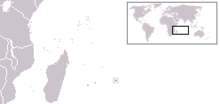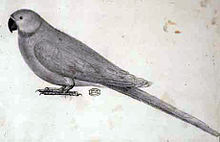Newton's parakeet
| Newton's parakeet | |
|---|---|

| |
Life drawing by Paul Jossigny, 1770s
| |
| Scientific classification | |
| Domain: | Eukaryota |
| Kingdom: | Animalia |
| Phylum: | Chordata |
| Class: | Aves |
| Order: | Psittaciformes |
| Family: | Psittaculidae |
| Genus: | Psittacula |
| Species: | †P. exsul
|
| Binomial name | |
| †Psittacula exsul (Newton, 1872)
| |

| |
| Location of Rodrigues | |
| Synonyms | |
| |
Newton's parakeet (Psittacula exsul), also known as the Rodrigues parakeet or Rodrigues ring-necked parakeet, is an
Around 40 centimetres (16 in) long, Newton's parakeet was roughly the size of a rose-ringed parakeet. Its
Newton's parakeet was first written about by the French
Taxonomy

Newton's parakeet was first recorded by
In 1871, George Jenner, the British
A. Newton requested further specimens, especially males, but in 1875 he finally published a plate of the female, lamenting that no male specimens could be found. Tafforet's 1726 account had been rediscovered the previous year, and A. Newton noted that it confirmed his assumption that the male would turn out be much more colourful than the female. Newton's collector, the English naturalist Henry H. Slater, had seen a live Newton's parakeet the year before, but was not carrying a gun at the time.[6][7] On 14 August 1875, William Vandorous shot a male specimen.[8] It may have been the same specimen Slater had observed. It was subsequently sent to E. Newton by William J. Caldwell.[9] This is the paratype of the species, numbered UMZC 18/Psi/67/h/2 and housed in the Cambridge Museum.[3]
In 1876, the Newton brothers noted that they had expected the male would be adorned with a red patch on the wing, but that the absence of this indicated it was immature. They still found it more beautiful than the female.
Evolution

Based on
Many endemic Mascarene birds, including the
A 2011

| |||||||||||||||||||||||||||||||||||||
In 2018, the American ornithologist Kaiya L. Provost and colleagues found the
A 2022 genetic study by the Brazilian ornithologist Alexandre P. Selvatti and colleagues confirmed the earlier studies in regard to the relationship between Psittacula, the Mascarene parrot, and Tanygnathus. They suggested that Psittaculinae originated in the
Description

Newton's parakeet was about 40 cm (16 in) long – roughly the size of the rose-ringed parakeet.
The general appearance of Newton's parakeet was similar to the extant Psittacula species, including the black collar, but the bluish grey colouration set it apart from other members of its genus, which are mostly green.[19] It differed from its Mascarene relatives in some skeletal details, including in that the internal margin of the mandibular symphysis (where the two halves of the lower jaw connected) was oval instead of square-shaped when seen from above, and in that the upper end of the humerus (upper arm bone) was less expanded than in the Mascarene grey parakeet and the echo parakeet.[3]
Possible colour variation
The French naturalist Philibert Commerson received a live specimen on Mauritius in the 1770s and described it as "greyish blue". French artist Paul Philippe Sanguin de Jossigny made two illustrations of this specimen, the only known depictions of Newton's parakeet in life, unpublished until 2007.[3] Though both existing specimens are blue, some early accounts from Rodrigues have caused confusion over the colouration of the plumage.[19] One of these is Leguat's following statement:
There are abundance of green and blew Parrets, they are of a midling and equal bigness; when they are young, their Flesh is as good as young Pigeons.[3]
If the green parrots Leguat referred to were not the
The two existing specimens were originally preserved in alcohol, but though this can discolour specimens, it is not probable that it could turn green to blue.
Tafforet also described what appears to be green Newton's parakeets, but the issue of colouration was further complicated by the mention of red plumage:
The parrots are of three kinds, and in quantity ... The second species [mature male Newton's parakeet?] is slightly smaller and more beautiful, because they have their plumage green like the preceding [Rodrigues Parrot], a little more blue, and above the wings a little red as well as their beak. The third species [Newton's parakeet] is small and altogether green, and the beak black.[3]
In 1987, the British ecologist
Behaviour and ecology
Almost nothing is known about the behaviour of Newton's parakeet, but it is probable that it was similar to that of other members of its genus. Leguat mentioned that the parrots of the island ate the nuts of the bois d'olive tree (Cassine orientalis). Tafforet also stated that the parrots ate the seeds of the bois de buis shrub (Fernelia buxifolia), which is endangered today, but was common all over Rodrigues and nearby islets during his visit.[3] Newton's parakeet may have fed on leaves as the related echo parakeet does. The fact that it survived long after Rodrigues had been heavily deforested shows that its ecology was less vulnerable than that of, for example, the Rodrigues parrot.[13]
Leguat and his men were hesitant to hunt the parrots of Rodrigues because they were so tame and easy to catch.[12] Leguat's group took a parrot as a pet and were able to teach it to speak:
Hunting and Fishing were so easie to us, that it took away from the Pleasure. We often delighted ourselves in teaching the Parrots to speak, there being vast numbers of them. We carried one to Maurice Isle [Mauritius], which talk'd French and Flemish.[13]
The authors of the 2015 study which resolved the phylogenetic placement of the Mascarene island parakeets suggested that the echo parakeet of Mauritius would be a suitable
Many other species endemic to Rodrigues became extinct after humans arrived, and the island's ecosystem remains heavily damaged. Forests had covered the entire island before humans arrived, but very little forestation can be seen today. Newton's parakeet lived alongside other recently extinct birds such as the Rodrigues solitaire, the Rodrigues parrot, the Rodrigues rail, the Rodrigues starling, the Rodrigues scops owl, the Rodrigues night heron, and the Rodrigues pigeon. Extinct reptiles include the domed Rodrigues giant tortoise, the saddle-backed Rodrigues giant tortoise, and the Rodrigues day gecko.[13]
Extinction

Of the roughly eight parrot species endemic to the Mascarenes, only the echo parakeet has survived. The others were likely all made extinct by a combination of excessive hunting and deforestation by humans.[3] Leguat stated that Newton's parakeet was abundant during his stay. It was still common when Tafforet visited in 1726, but when Pingré mentioned it in 1761, he noted that the bird had become scarce. It was still present on southern islets off Rodrigues (Isle Gombrani), along with the Rodrigues parrot. After this point, much of Rodrigues was severely deforested and used for livestock.[3]
According to early accounts praising its flavour, it appears visitors commonly ate Newton's parakeet.[13] Several individuals would likely be needed to provide a single meal, owing to the bird's small size.[19] Pingré stated:
The perruche [Newton's parakeet] seemed to me much more delicate [than the flying-fox]. I would not have missed any game from France if this one had been commoner in Rodrigues; but it begins to become rare. There are even fewer perroquets [Rodrigues parrots], although there were once a big enough quantity according to François Leguat; indeed a little islet south of Rodrigues still retains the name Isle of Parrots [Isle Pierrot].[3]
According to government surveyor Thomas Corby, Newton's parakeet may still have been fairly common in 1843. Slater reported that he saw a single specimen in southwestern Rodrigues during his three-month stay to observe the
There were unfounded rumours of its continued existence until the beginning of the 20th century.[13] In 1967, the American ornithologist James Greenway stated that an extremely small population might still survive on small offshore islets, since this is often the last refuge of endangered birds.[22] The Mauritian ornithologist France Staub stated in 1973 that his visits to Rodrigues the previous seven years confirmed the bird was extinct.[23] Hume concluded in 2007 that the islets were probably too small to sustain a population.[3]
References
- .
- ^ Leguat, F. (1891). Oliver, S. P. (ed.). The voyage of François Leguat of Bresse, to Rodriguez, Mauritius, Java, and the Cape of Good Hope. Vol. 1. London: Hakluyt Society. pp. 84–85.
- ^ .
- ^ Newton, A. (1875). "Additional evidence as to the original fauna of Rodriguez". Proceedings of the Zoological Society of London. 1875: 39–43.
- .
- .
- ^ Cheke, A. S. (2019). "Unpublished material from the Transit of Venus expedition to Rodrigues in 1874 - Henry Slater's sketchbook and notes on the birds of Rodrigues". Journal of the Royal Society of Arts & Sciences of Mauritius. 1: 48–56.
- ^ .
- S2CID 128901896.
- ^ Rothschild, W. (1907). Extinct Birds. London: Hutchinson & Co. p. 65.
- S2CID 41950882.
- ^ ISBN 978-1-4081-5725-1.
- ^ ISBN 978-0-7136-6544-4.
- PMID 22019932.
- ^ .
- S2CID 52995298.
- S2CID 91969786.
- .
- ^ ISBN 978-0-670-81787-0.
- ^ Hume, J. P.; van Grouw, H. (2014). "Colour aberrations in extinct and endangered birds". Bulletin of the British Ornithologists' Club. 134: 168–193.
- ISBN 978-0-521-11331-1.
- ISBN 978-0-486-21869-4.
- OCLC 6800045.
External links
 Media related to Psittacula exsul at Wikimedia Commons
Media related to Psittacula exsul at Wikimedia Commons Data related to Psittacula exsul at Wikispecies
Data related to Psittacula exsul at Wikispecies



